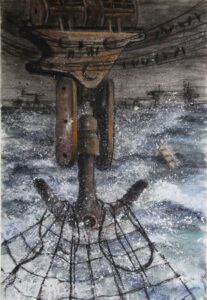Salt and Flesh
The fish is a fragment severed from the sea.
The sea is a fragment that still continues.
This exhibition is a visual dialogue
between what has been separated
and what remains.
This exhibition has no statement. It is a visual conversation between two subjects: the dead fish (still life) and the sea (landscape).
__
Further Reading 1: Aesthetic Analysis
The visual dialogue between the dead fish and the sea serves as a ground for exploring the tension between form and meaning.
According to Maurice Merleau-Ponty, the viewer’s experience is not merely optical, but embodied—shaped through sensation and physical presence. Color, texture, and form invite tactile and perceptual engagement, transforming the viewer from a passive observer into a participant in the image.
In parallel, Claude Lévi-Strauss’s structuralist perspective reveals a dual system at play: life/death, stillness/movement, presence/absence. The binary opposition between still life (the fish) and the living landscape (the sea) generates a visual language of contrast and interconnectedness, allowing meaning to emerge through form, beyond literal representation.
__
Further Reading 2: Visual Dialogue
Visual Dialogue refers to a mode of artistic expression in which visual elements communicate in place of spoken or written language. Meaning arises through juxtaposition, repetition, contrast, or formal interplay—not through verbal explanation.
Here, the dead fish and the sea are visual agents. One is static, closed, finite; the other is expansive, fluid, ongoing. The dialogue between them unfolds silently, offering no direct answers or messages—only an open invitation to see, reflect, and construct meaning through the aesthetic experience.
__
Further Reading 3: Narrative in This Exhibition
Though this exhibition lacks an explicit narrative, it is not without story. The narrative here is nonverbal and non-linear, emerging through image, relation, and resonance. The juxtaposition of the dead fish and the sea evokes a primal sequence:
origin (life), rupture (death), and representation (image).
In classical narratology, Tzvetan Todorov identifies three stages: equilibrium, disruption, and new equilibrium. This structure can be traced visually across the works in the exhibition.
Likewise, Roland Barthes, in his concept of “zero degree writing,” emphasizes that narrative can be constructed beyond language—through silence, absence, and image. Each frame here carries a fragment of a silent narrative, assembled anew in the mind of the viewer.


